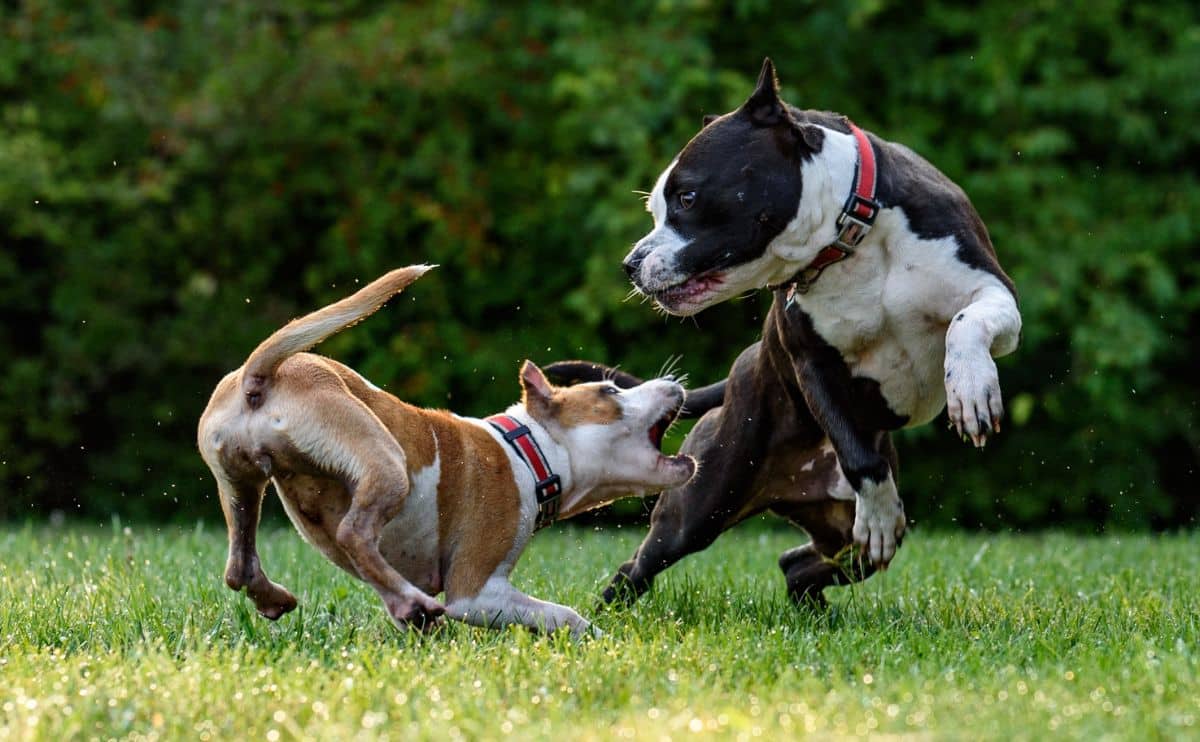When you purchase through links on our site, we may earn a commission. Here’s how it works.

According to a study from the Center For Disease Control (CDC), approximately 4.5 million dog bites occur in the United States each year, and 800,000 of those bites result in medical care. The U.S. population is approximately 334.7 million people in 2023. That means a dog bites 1 out of every 74 people. These are scary statistics. But scary becomes a lot less so when you’re armed with the right information. From the dogs most likely to bite to considering your behavior around animals to why dogs bite in the first place, we give you an arsenal of information so that you can bite back in the dog bite debate.
Note: This article is based on third-party statistics. It does not necessarily represent the opinions of this website.
- Why Do Dogs Bite? 5 Reasons
- 7 Dog Bite Statistics
- 11 Dog Breeds That Bite Most Often
- Which Breeds Have The Strongest Bite? Top 12 Dogs
- How To Protect Yourself Against The Risk Of Dog Bites
- 5 Things To Consider Before Getting A Dog
- Dog Bite Statistics Infographic 2023
- Be Mindful Of "Breeds," But Not Fearful
Why Do Dogs Bite? 5 Reasons
Before we start profiling dogs or analyzing your behavior around them, let’s talk about the question everyone should first be asking: why does a dog bite?
- Dogs bite as a reaction to a stressful situation.
- They may be scared or threatened.
- To protect themselves, their puppies, or their owners.
- They’re not feeling well, or if they’re startled.
- They may nip or bite during play (which is why rough play should be avoided to ensure you don’t overly excite your animal).
Keep these triggers in mind anytime you’re around a canine. Your awareness of their mental state will help you recognize a potential bite situation more quickly.
7 Dog Bite Statistics
Here are a few shocking stats we’ve compiled from various experts and resources.
- 81% of dog bites cause no injury at all or only minor injuries that do not require medical attention (Source: National Canine Research Council)
- You have a 1 in 53,843 chance of dying from a dog bite (Source: National Safety Council)
- Dogs who are not spayed or neutered are more likely to have aggressive behavior (Source: The Humane Society)
- Most dog bites involve dogs who are not spayed or neutered (Source: The Humane Society)
- 25% of fatal attacks were inflicted by chained dogs of many different breeds, according to Fatal Dog Attacks
- The insurance industry paid more than $881 million in dog bite-related claims in 2021 (Source: Insurance Information Institute)
- More than 5,400 USPS employees were attacked by a dog in 2021 (down from 5,714 in 2019)
- More than 12 breeds (not including mixed breeds were associated with dog bite-related fatalities in 2022 (Source: Wikipedia)
Video: Dog Bite Statistics
The video below discusses dog bite statistics.
11 Dog Breeds That Bite Most Often
Wondering what dogs that bite the most? Here’s a list of the dog breeds known to bite the most frequently, according to Puppy Lover News.
- Chihuahua
- English Bulldog
- Pit Bull
- German Shepherd
- Australian Shepherd
- Lhasa Apso
- Jack Russell Terrier
- Cocker Spaniel
- Bull Terrier
- Pekingese
- Papillion
Which Breeds Have The Strongest Bite? Top 12 Dogs
In addition to what breed of dog bites the most, below are the top 12 dogs with the strongest bite in terms of PSI (pound per square inch or pound-force per square inch), as reported by Pet Comments. This list is not indicative of any specific animal and should only be viewed as a scientific study. We certainly recognize that there are many well-behaved and sweet dogs of these breeds, especially when paired with responsible owners.
- Kangal: 743 PSI
- American Bandogge: 730 PSI
- Cane Corso: 700 PSI
- Dogue De Bordeaux: 556 PSI
- Tosa Inu: 556 PSI
- English Mastiff: 556 PSI
- Dogo Canario: 540 PSI
- Dogo Argentino: 500 PSI
- Wolfdog: 406 PSI
- Leonberger: 399 PSI
- Akita Inu: 350-400 PSI
- Rottweiler: 328 PSI
How To Protect Yourself Against The Risk Of Dog Bites
Dog liability insurance is a special policy that you can get to insure yourself in case you have what a landlord or other important person in your life might consider a “dangerous dog breed.” If you have one of these dogs, you most certainly know it, as some people are probably a little scared of your pup. It is unlikely that they need to be, but better safe than sorry in case a situation ever were to arise where your dog bit someone.
Why? Because with liability insurance, you would merely file a claim, and it would cover the cost of the situation. In many cases, we have heard of dogs’ lives being saved by the ability to cover these sorts of incidents by proactively seeking insurance rather than reacting after a bad situation occurs. Better safe than sorry, right?
According to the Insurance Information Institute, the average cost per liability claim related to dog bites and other dog-related injuries in 2022 was $64,555.
Decrease Your Chances Of A Dog Bite Attack
While we’re not absolving the canine completely of its own responsibility in a dog-bite situation, there are always two sides to a story — even a bad one. When it comes to your side, there are a few things that you can do to decrease your chances of an attack.
8 Tips On How To Prevent A Dog Bite
Just like people, there are always good pets that snap. Even though the dog never displayed any aggressive attitudes, even though you didn’t provoke him to attack, there are still those unaccountable instances that no one can explain or rationalize. However, more often than not, this isn’t the case. That’s why, when dealing with any dog, you should maintain confidence but cautious body language. Below are a few things you can do to make sure your attitude doesn’t trigger an attack.
- Don’t approach an unfamiliar animal.
- Do not run from a dog, panic, or make loud noises.
- If an unfamiliar dog approaches you, remain motionless. Do not run or scream. Avoid direct eye contact.
- Don’t disturb a dog while they’re eating, sleeping, or taking care of their puppies.
- Allow a dog to sniff and smell you before you attempt to pet it. Afterward, scratch the animal under the chin, not on the head.
- Report strays or dogs displaying strange behavior to your local animal control.
- If knocked over by a dog, roll into a ball and remain motionless. Be sure to cover your ears and neck with your hands and arms. Avoid eye contact and remain calm.
- Don’t encourage your dog to play aggressively.
5 Things To Consider Before Getting A Dog
There are a few key things to consider before bringing a new dog into your home, especially if you already have other animals or children. Below are a few factors that, if considered, can help decrease your chances of an unwarranted attack before an animal ever walks through your front door.
- Dogs with a history of aggression are inappropriate for a home with children. Period.
- Before choosing a dog, research and consult with a professional (a trusted vet or dog trainer would be an excellent resource) to find the best breed for your needs.
- Proper socialization and training for your pup are key.
- Spend time with your prospective pet before adopting to ascertain aggressive tendencies.
- Spay or neuter your animal to reduce aggressive tendencies before bringing them home.
Dog Bite Statistics Infographic 2023

Be Mindful Of “Breeds,” But Not Fearful
You’ve likely heard of the Pit Bull, touted as the type most responsible for dog bites. But you can dismantle much of your fear of them with our Pit Bull Facts article. Unfortunately, claims against Pit Bulls account for the majority of reported fatal attacks in the United States (again, many of these are misreported due to a lack of understanding of dog breeds and types). While there’s no denying that one should be more vigilant around a large dog than, say, a Beagle, there’s also no denying that an animal is a part product of their environment.
Remember that any dog can bite, no matter how well-trained it may be. Many popular family dogs have caused fatalities, including Labradors and German Shepherds. So it is always a good idea to be a responsible dog owner and make sure pets are supervised at all times with others. Finally, if you have a dog that’s prone to biting, consider a training collar or online training courses to help change their bad behavior.
Tagged With: Biting, Liability

